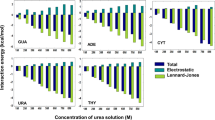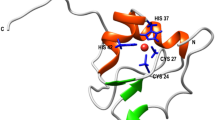Abstract
Here we investigate conformational folding reaction of disulphide-intact ribonuclease A in the absence of the complicating effects due to non-native interactions (such as cis/trans proline isomerization) in the unfolded state. The conformational folding process is found to be intrinsically very fast occurring on the milliseconds time scale. The kinetic data indicate that the conformational folding of ribonuclease A proceeds through the formation of a hydrophobically collapsed intermediate with properties similar to those of equilibrium molten-globules. Furthermore, the data suggest that the rate-limiting transition states on the unfolding and refolding pathways are substantially different with the refolding transition state having non-native-like properties.
This is a preview of subscription content, access via your institution
Access options
Subscribe to this journal
Receive 12 print issues and online access
$189.00 per year
only $15.75 per issue
Buy this article
- Purchase on Springer Link
- Instant access to full article PDF
Prices may be subject to local taxes which are calculated during checkout
Similar content being viewed by others
References
Kim, P.S. & Baldwin, R.L. Intermediates in the folding reactions of small proteins. A. Rev. Biochem. 59, 631–660 (1990).
Nail, B.T. Proline isomerization as a rate-limiting step. In Mechanisms of protein folding (ed. Pain, R. H.) 80–103 (Oxford University Press, New York; 1994).
Sosnick, T.R., Mayne, L., Hiller, R. & Englander, S.W. The barriers in protein folding. Nature struct. Biol. 1, 149–156 (1994).
Matheson, R.R. Jr. & Scheraga, H.A. A method for predicting nucleation sites for protein folding based on hydrophobic contacts. Macromolecules 11, 819–829 (1978).
Baldwin, R.L. How does protein folding get started? Trends biochem. Sci. 14, 291–294 (1989).
Dill, K.A., Fiebig, K.M. & Chan, H.S. Cooperativity in protein-folding kinetics. Proc. natn. Acad. Sci. U.S.A. 90, 1942–1946 (1993).
Ptitsyn, O.B. Protein folding: hypotheses and experiments. J. prot. Chem. 6, 273–293 (1987).
Kuwajima, K. The molten globule state as a clue for understanding the folding and cooperativity of globular-protein structure. Proteins Struct. Funct. Genet. 6, 87–103 (1989).
Christensen, H. & Pain, R.H. The contribution of the molten globule model. In Mechanisms of protein folding (ed. Pain, R. H.) 55–79 (Oxford University Press, New York; 1994).
Barrick, D. & Baldwin, R.L. The molten globule intermediate of apomyoglobin and the process of protein folding. Prot. Sci. 2, 869–876 (1993).
Yutani, K., Ogasahara, K. & Kuwajima, K. Absence of the thermal transition in apo-α-lactalbumin in the molten golbule state: a study by differential scanning microcalorimetry. J. molec. Biol. 228, 347–350 (1992).
Goto, Y. & Fink, A.L. Conformational states of β-lactamase: molten-globule states at acidic and alkaline pH with high salt. Biochemistry 28, 945–952 (1989).
Ptitsyn, O.B., Pain, R.H., Semisotnov, G.V., Zerovnik, E. & Razgulyaev, O.I. Evidence for a molten globule state as a general intermediate in protein folding. FEBS Lett. 262, 20–24 (1990).
Kuwajima, K., Hiraoka, Y., Ikeguchi, M. & Sugai, S. Comparison of the transient folding intermediates in lysozyme and α-lactalbumin. Biochemistry 24, 874–881 (1985).
Garvey, E.P., Swank, J. & Matthews, C.R. A hydrophobic cluster forms early in the folding of dihydrofolate reductase. Proteins Struct. Funct., Genet. 6, 259–266 (1989).
Jennings, P.A. & Wright, P.E. Formation of a molten globule intermediate early in the kinetic folding pathway of apomyoglobin. Science 262, 892–896 (1993).
Wlodawer, A., Svensson, L.A., Sjölin, L. & Gilliland, G.L. Structure of phosphate-free ribonuclease A refined at 1.26 Å. Biochemistry 27, 2705–2717 (1988).
Schmid, F.X. Fast-folding and slow-folding forms of unfolded proteins. Meths Enzymol. 131, 70–82 (1986).
Houry, W.A., Rothwarf, D.M. & Scheraga, H.A. A very fast phase in the refolding of disulphide-intact ribonuclease A: implications for the refolding and unfolding pathways. Biochemistry 33, 2516–2530 (1994).
Pace, C.N., Laurents, D.V. & Thomson, J.A. pH dependence of the urea and guanidine hydrochloride denaturation of ribonuclease A and ribonuclease T1. Biochemistry 29, 2564–2572 (1990).
Pace, C.N. Determination and analysis of urea and guanidine hydrochloride denaturation curves. Meths Enzymol. 131, 266–280 (1986).
Schellman, J.A. The thermodynamic stability of proteins. A. Rev. Biophys. biophys. Chem. 16, 115–137 (1987).
Alonso, D.O.V. & Dill, K.A. Solvent denaturation and stabilization of globular proteins. Biochemistry 30, 5974–5985 (1991).
Tanford, C. Protein denaturation. Theoretical models for the mechanism of denaturation. Adv. protein Chem. 24, 1–95 (1970).
Glasstone, S., Laidler, K.J. & Eyring, H. The Theory of Rate Processes 1–27 (McGraw-Hill Book Company, New York; 1941).
Donovan, J.W., Laskowski, Jr., M. & Scheraga, H.A. Carboxyl group interactions in lysozyme. J. molec. Biol. 1, 293–296 (1959).
Nozaki, Y. & Tanford, C. Proteins as random coils. II. Hydrogen ion titration curve of ribonuclease in 6 M guanidine hydrochloride. J. Am. chem. Soc. 89, 742–749 (1967).
Greenstein, J.P. Studies of the peptides of trivalent amino acids. J. biol. Chem. 101, 603–621 (1933).
Kauzmann, W. Some factors in the interpretation of protein denaturation. Adv. Protein Chem. 14, 1–63 (1959).
Tanford, C. The hydrophobic effect: Formation of micelles and biological membranes 16–23 (John Wiley & Sons, New York; 1973).
Némethy, G. & Scheraga, H.A. The structure of water and hydrophobic bonding in proteins. III. The thermodynamic properties of hydrophobic bonds in proteins. J. phys. Chem. 66, 1773–1789 (1962).
Scheraga, H.A. Treatment of hydration in conformational energy calculations on polypeptides and proteins. In Structure and reactivity in aqueous solution (ed. Cramer, C. J. & Truhlar, D. G.) 360–370 (ACS Symposium Series No. 568, Washington, DC; 1994).
Privalov, P.L. & Gill, S.J. Stability of protein structure and hydrophobic interaction. Adv. prot. Chem. 39, 191–234 (1988).
Creighton, T.E. Electrophoretic analysis of the unfolding of proteins by urea. J. molec. Biol. 129, 235–264 (1979).
Makhatadze, G.I. & Privalov, P.L. Protein interactions with urea and guanidinium chloride. A calorimetric study. J. molec. Biol. 226, 491–505 (1992).
Haynie, D.T. & Freire, E. Structural energetics of the molten globule state. Proteins Struct. Funct. Genet. 16, 115–140 (1993).
Xie, D. & Freire, E. Molecular basis of cooperativity in protein folding. V. Thermodynamic and structural conditions for the stabilization of compact denatured states. Proteins Struct. Funct. Genet. 19, 291–301 (1994).
Creighton, T.E. Toward a better understanding of protein folding pathways. Proc. natn. Acad. Sci. U.S.A. 85, 5082–5086 (1988).
Matouschek, A., Kellis, Jr, J.T., Serrano, L. & Fersht, A.R. Mapping the transition state and pathway of protein folding by protein engineering. Nature 340, 122–126 (1989).
Fersht, A.R., Kellis, J.T. Jr, Matouschek, A.T.E.L. & Serrano, L. Folding pathway enigma. Nature 343, 602 (1990).
Brandts, J.F., Halvorson, H.R. & Brennan, M. Consideration of the possibility that the slow step in protein denaturation reactions is due to cis-transisomerism of proline residues. Biochemistry 14, 4953–4963 (1975).
Lin, S.H., Konishi, Y., Nail, B.T. & Scheraga, H.A. Influence of an extrinsic cross-link on the folding pathway of ribonuclease A. Kinetics of folding-unfolding. Biochemistry 24, 2680–2686 (1985).
Antosiewicz, J., McCammon, J.A. & Gilson, M.K. Prediction of pH-dependent properties of proteins. J. molec. Biol. 238, 415–436 (1994).
Good, N.E., Winget, G.D., Winter, W., Connolly, T.N., Izawa, S. & Singh, R.M.M. Hydrogen ion buffers for biological research. Biochemistry 5, 467–477 (1966).
Good, N.E. & Izawa, S. Hydrogen ion buffers. Meths Enzymol. 24, 53–68 (1972).
Edsall, J.T. Dipolar ions and acid-base equilibria. In Proteins, amino acids and peptides as ions and dipolar ions (eds Cohn, E.J. & Edsall, J.T.) 75–115 (Reinhold Publishing Corporation, New York; 1943).
Caceci, M.S. & Caheris, W.P. Fitting curves to data. BYTE 9, 340–362 (1984).
Author information
Authors and Affiliations
Rights and permissions
About this article
Cite this article
Houry, W., Rothwarf, D. & Scheraga, H. The nature of the initial step in the conformational folding of disulphide-intact ribonuclease A. Nat Struct Mol Biol 2, 495–503 (1995). https://doi.org/10.1038/nsb0695-495
Received:
Accepted:
Issue Date:
DOI: https://doi.org/10.1038/nsb0695-495
This article is cited by
-
Hydrophobic Hydration: A Theoretical Investigation of Structure and Dynamics
Journal of Chemical Sciences (2023)
-
Multiple intermediates and transition states during protein unfolding
Nature Structural Biology (1997)
-
Evidence for a three-state model of protein folding from kinetic analysis of ubiquitin variants with altered core residues
Nature Structural Biology (1996)



